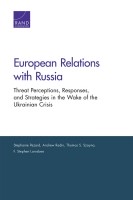| 来源类型 | Research Reports
|
| 规范类型 | 报告
|
| DOI | https://doi.org/10.7249/RR1579
|
| ISBN | 9780833096371
|
| 来源ID | RR-1579-A
|
| European Relations with Russia: Threat Perceptions, Responses, and Strategies in the Wake of the Ukrainian Crisis |
| Stephanie Pezard; Andrew Radin; Thomas S. Szayna; F. Stephen Larrabee
|
| 发表日期 | 2017
|
| 出版年 | 2017
|
| 页码 | 120
|
| 语种 | 英语
|
| 结论 |
Perceptions of Russia as a Military Threat Differ Sharply Across Europe and Appear to be Heavily Influenced by Geographical Proximity to Russia- Some of Russia's neighbors see Russia as capable of and potentially willing to carry out a conventional attack against them but do not necessarily see such an attack as likely.
- Some European countries, particularly eastern NATO members, are concerned that the Alliance is ill equipped to respond to the current crisis with Russia.
European Countries Have Adopted a Broad Range of Measures in Response to the Ukrainian Crisis- That Russia's behavior requires a strong response is widely accepted by most European countries.
- NATO has begun its adaptation to the new threat environment.
- Responses to Russia's strategic communication efforts and internal destabilization efforts have been limited.
- While agreeing on a firm response to Russia's aggressive moves, most European countries have also made sure to pursue dialogue with Russia on Ukraine-related issues as well as other matters of mutual interest.
European Officials Interviewed Generally Agreed on Three Key Elements that Shape Their Current Relations with Russia and Likely Will Continue to Do So in the Near Future- Relations with Russia have changed irremediably.
- Tensions are unlikely to recede anytime soon.
- Future actions toward Russia depend on Russian behavior.
|
| 摘要 |
- The Department of Defense should take a serious look at Russian capabilities to politically subvert a Baltic state, including the seizure of a border enclave and/or fomenting internal unrest. DoD could use political-military games to understand the potential Alliance difficulties in reaching consensus, the options open to NATO, and the time required. More-detailed assessment of the Baltic internal security forces and their ability to deal with potential subversion contingencies also would be valuable.
- DoD should seek a better understanding of the Russian ability to prevent reinforcement to the Baltic States; DoD could subject some of the "unusual" scenarios, like the seizure of Gotland, to modeling and simulation. Similarly, for sustained air operations over the Baltic States, how important does access to Swedish (and possibly Finnish) airspace become?
- DoD should seek a clear view of the role that Kaliningrad might play, with its strong antiair defenses; how would NATO neutralize them?
|
| 主题 | European Union
; Global Security
; North Atlantic Treaty Organization
; Russia
; Ukraine
|
| URL | https://www.rand.org/pubs/research_reports/RR1579.html
|
| 来源智库 | RAND Corporation (United States)
|
| 引用统计 |
|
| 资源类型 | 智库出版物
|
| 条目标识符 | http://119.78.100.153/handle/2XGU8XDN/108652
|
推荐引用方式
GB/T 7714 |
Stephanie Pezard,Andrew Radin,Thomas S. Szayna,et al. European Relations with Russia: Threat Perceptions, Responses, and Strategies in the Wake of the Ukrainian Crisis. 2017.
|
|
文件名:
|
x1535050417864.jpg
|
|
格式:
|
JPEG
|

|
文件名:
|
RAND_RR1579.pdf
|
|
格式:
|
Adobe PDF
|
除非特别说明,本系统中所有内容都受版权保护,并保留所有权利。